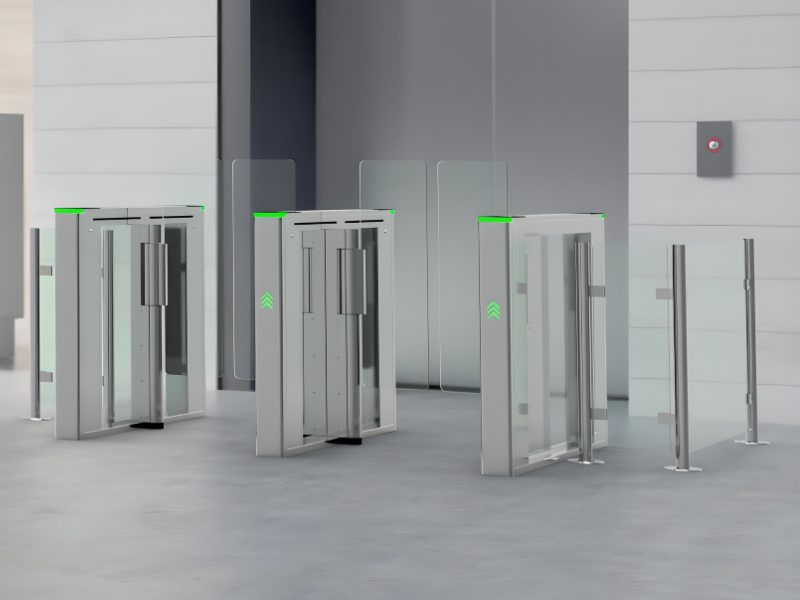Access control solutions play a vital role in modern businesses, providing enhanced security and efficient management of foot traffic. Among the most popular options are speed gates and turnstiles. But how do they differ, and which one is best for your business needs? Let’s take a dive into the features, benefits, and applications of both speed gates and turnstiles to help you make an informed decision!
What Are Speed Gates?
Design and Functionality
Speed gates are sleek, modern access control systems designed for smooth and efficient operation. They typically feature glass barriers that retract or slide open to allow passage once access is granted. Advanced sensors ensure a seamless and user-friendly experience.
How They Work
Speed gates rely on technology such as RFID cards, biometrics, or QR code scanners to authenticate users. Once access is approved, the glass panels quickly open and close to ensure secure passage. Some models can integrate with building management systems for added functionality. The EA Swing Land Speed Gate has both manual and automatic modes available for control either via a reception desk, or a key fob or biometric reader.
Applications of Speed Gates
Speed gates are ideal for high-end environments where aesthetics and efficiency are paramount. Common applications include:
- Corporate offices
- Airports and VIP lounges
- Government buildings
- High-tech facilities
Speed gates offer an elegant, modern solution that complements sophisticated architectural designs.
What Are Turnstiles?
Design and Functionality
Turnstiles are robust and utilitarian, designed to control and monitor pedestrian access. They come in several types, including:
- Tripod Turnstiles: Three arms rotate to allow one person at a time.
- Full-Height Turnstiles: Offer maximum security with a cage-like design.
- Glass Pass Turnstiles: a more aesthetically pleasing full height turnstile.
How They Work
Turnstiles require users to present an access credential, such as a ticket, RFID card, or biometric data. The mechanism allows a single person to pass at a time, ensuring controlled entry and exit.
Applications of Turnstiles
Turnstiles are well-suited for environments with high foot traffic and stringent security requirements, such as:
- Stadiums and arenas
- Public transportation hubs
- Amusement parks
- Factories and industrial sites
Turnstiles are known for their durability and ability to handle large crowds effectively.
Key Differences Between Speed Gates and Turnstiles
Design and Aesthetics
Speed gates boast a modern, streamlined look with glass panels, making them ideal for office and corporate environments. Turnstiles, on the other hand, are more utilitarian, emphasising durability over aesthetics.
User Flow and Speed
Speed gates allow for faster throughput, as their automated sensors can handle multiple entries and exits efficiently. Speed gates can handle up to 30 persons per minute throughput. Turnstiles, with their single-person mechanism, may slow down user flow but offer greater control, and therefore security.
Level of Security
Full-height turnstiles provide a physical barrier that is difficult to bypass, making them a better choice for high-security areas. Speed gates, while secure, are more focused on elegance and convenience.
Cost and Maintenance
Turnstiles are typically more affordable upfront and require less maintenance due to their simpler mechanisms. Speed gates, with advanced technology and sensors, may have higher initial and maintenance costs.
| Feature | Speed Gates | Turnstiles |
| Design | Sleek, modern glass panels | Durable, utilitarian metal |
| Throughput Speed | High | Moderate |
| Security | Medium-High | High |
| Cost | Higher initial cost | More affordable upfront |
| Ideal Use Cases | Premium facilities, offices | Stadiums, public transport |
How to Choose the Right Solution for Your Business
Selecting the right access control system depends on your business’s unique needs. Here are some factors to consider:
1. Security Requirements
- If your priority is maximum security, full-height turnstiles might be the best option.
- For environments requiring moderate security with a focus on aesthetics, speed gates are a better choice.
2. Foot Traffic
- High-traffic areas with a need for quick throughput benefit from speed gates.
- Areas requiring stricter control for individual entry are better suited for turnstiles.
3. Budget
- Consider not just the initial cost but also the long-term maintenance expenses. Turnstiles are cost-effective, while speed gates require a larger investment.
4. Aesthetics and Environment
- For modern offices or premium facilities, speed gates align better with the design ethos.
- Turnstiles are a practical choice for industrial or outdoor settings.
5. Integration with Other Systems
- Both options can integrate with advanced technologies, but speed gates often offer more customization options for modern smart building systems.
Conclusion: Speed Gates vs Turnstiles
Speed gates and turnstiles each serve distinct purposes, and understanding their differences is key to making the right choice for your business. Speed gates excel in modern, high-throughput environments, while turnstiles provide robust security in high-traffic or industrial settings.
Need help selecting the perfect access control solution? At EA Group, we’ve been helping businesses with access control solutions for over 30 years. Whether you need sleek speed gates or durable turnstiles, our expert team is here to assist. Contact us today to find out more!






















1 thought on “What’s the difference between Speed Gates and Turnstiles?”